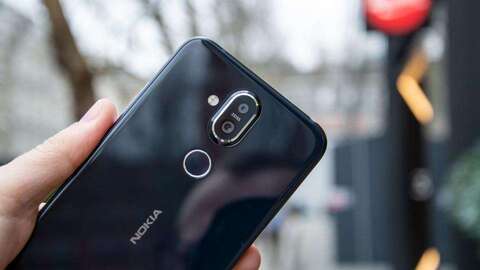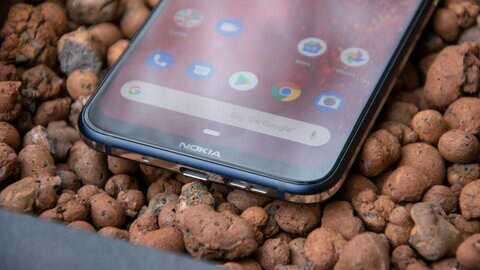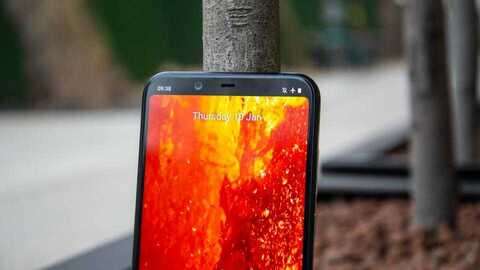Nokia 8.1 review: A marvellous mid-range smartphone
I wasn’t entirely convinced that Nokia deserved to be thrust back into the limelight. Cautiously sceptical, I didn’t have high hopes for the once-great phone maker to succeed with its big re-do back in 2017, and anticipated that its “grand resurgence” would be fleeting at best.
READ NEXT: The very best smartphones
But Nokia’s revival is close to entering its third year, and its wide-ranging smartphone offering is only getting stronger. With a presence in every possible price bracket – especially succeeding in the mid-range market – the Nokia train keeps chugging along, and the Nokia 8.1 is perhaps its most persuasive offering yet.
Nokia 8.1 review: What you need to know
Considered a “value flagship”, the Nokia 8.1 undercuts pricey phones such as the iPhone Xs and Huawei Mate 20 Pro by a significant margin. Its internal specifications aren’t quite as flashy as a result, but it’s fitted with a massive 6.18in, 18:9 IPS display, along with a pair of 12- and 13-megapixel cameras on the rear of the handset. There’s a 20-megapixel selfie snapper embedded in a notch above the screen, too.

Qualcomm’s fresh-faced and intriguing octa-core Snapdragon 710 chipset powers the phone, which is clocked at 2.2GHz and works in tandem with 4GB of RAM and 64GB of onboard storage, expandable up to a further 400GB via microSD.
Nokia 8.1 review: Price and competition
In an age where the most expensive phones are breaking the four-figure mark, the Nokia 8.1’s asking price of £380 is actually quite refreshing.
The catch is that you can get a lot of decent phones in that price bracket. The terrific Xiaomi Pocophone F1 arrived in the UK at the tail end of last year which, despite costing a mere £330, manages to outdo phones that cost three times as much. Nokia itself has a handful of phones that slip into a similar price range too, such as the Nokia 7 Plus .
Best Nokia 8.1 contract and SIM-free deals:
Nokia 8.1 review: Design and features
The Nokia 8.1 looks very similar to the rest of Nokia’s fleet of smartphones. Crafted from a single block of aluminium, it’s not exactly a bold design, but the silver-tinted highlight around the phone’s edge looks particularly swish. At 8mm it’s agreeably slim in the hand, and the smooth-coated rear is very nice to hold.

Press the power button and you’ll notice how much of the Nokia 8.1’s frontage is dominated by that massive 6.18in, 18:9 screen. It isn’t quite borderless like the Xiaomi Mi Mix 3 , but its slim Galaxy S9-like chin bezel and skinny top notch help keep the handset’s overall dimensions to a pocketable 76 x 155mm.
The slightly-rounded corners are always a nice touch, and the screen is topped with a layer of NEG Dinorex to help protect from scratches and drops, rather than the Corning Gorilla Glass standard. A circular fingerprint reader is placed on the rear of the phone for secure unlocking, which sits just below the vertically-aligned dual-camera arrangement.
This brings me to a few small annoyances. The camera housing on the back of the Nokia 8.1 isn’t flush with the rest of the phone, protruding out quite a bit – which doesn’t play nicely when placed on flat surfaces such as desks and tables.
The Nokia 8.1 also lacks any kind of officially rated dust- or water-resistance, and it has no wireless charging. That said, you can expand the phone’s 64GB of onboard storage by an extra 400GB if you buy a microSD card. There’s also a 3.5mm headphone jack at the top of the phone, which is a bit of a rarity these days.
Nokia 8.1 review: Display
There’s much more to the Nokia 8.1’s 2,280 x 1,080 screen than just its size. In fact, this is a great IPS panel – we found that it was capable of covering 99.4% of the sRGB colour gamut on the phone’s “basic” colour profile, with an average Delta E of 1.16 (anything less than one is perfect).

In layman’s terms this means you’ll be swiping up and down on a phone screen that looks the best it possibly can, and can hold its own even against even the most discerning of eyeballs. A contrast ratio of 1,319:1 also ensures that images and text look pin-sharp, while a maximum screen brightness of 519cd/m2 is good enough for outdoor use.
Nokia 8.1 review: Performance and battery life
The Nokia 8.1 is powered by one of Qualcomm’s newer 700-series Snapdragon chips, rather than a top-end flagship processor like the Snapdragon 845. Still, this new 10nm Snapdragon 710 chipset is certainly no slouch, with eight cores clocked at up to 2.2GHz and an embedded Adreno 616 GPU.
The arrangement of its cores is actually rather interesting. Rather than your usual 4 x 4 symmetrical cluster configuration, the 710 chipset features a 2 x 6 arrangement (two of the cores are clocked at 2.2GHz, while the other six are clocked at 1.7GHz) which is supposed to be much more power efficient than the Snapdragon 660 chipset it supersedes.

The Nokia 8.1 proves to be just as capable when performing CPU-heavy tasks. Paired with 4GB of RAM, the Nokia 8.1 reached total scores of 1,809 and 5,853 in the Geekbench 4 single- and multi-core CPU tests. Aside from the Pocophone F1 with its Snapdragon 845, the Nokia 8.1 is as equally rapid as its similarly-priced rivals.
It’s a slightly more impressive story when it comes to gaming. Running the GFXBench GL Manhattan 3 onscreen and off-screen tests, the Nokia 8.1 produced average frame rates of 31 and 33fps respectively – that’s around 41% better than the Huawei Mate 20 Lite . Anecdotally, I didn’t run into any issues when playing games such as Fortnite and Alto’s Odyssey.
How about that stamina, then? Well, it appears this improved power efficiency isn’t so well optimised for video playback, as the Nokia 8.1 lasted 13hrs 59mins in our in-house battery test – which is 17% shorter than the Snapdragon 660-powered Nokia 7 Plus. That isn’t a bad result by any means, but I’m yet to see any improvements over Qualcomm’s older 600-series chips.
Nokia 8.1 review: Android One
The Nokia 8.1 is running Google’s latest version of its ever-popular mobile operating system, Android 9.0. This is pretty standard these days, but what’s particularly special is that the phone is Android One certified – a joint software agreement with the folks at Google ensuring the Nokia 8.1 receives three years of monthly security updates and guaranteed software updates for two years after the phone’s release.
Essentially, the Nokia 8.1 will get updates all the way until Android 11. If you’re playing the long game, and you’re after a phone that’ll stand the test of time better than most, then the Nokia 8.1 is a safe bet.
The Nokia 8.1 also offers a stock Android experience, free of any obtrusive third-party overlays. What this means is that you won’t get any unwanted apps pre-installed when you first boot up the phone and the software experience will function as simply and cleanly as possible.
Nokia 8.1 review: Camera
While some smartphone manufacturers are following the trend of triple and quadruple camera setups with their latest releases, the Nokia 8.1 is perfectly happy to stick with just two.
The rear camera is a 13-megapixel f/2.0 backed up by a secondary 13-megapixel depth-sensing unit for more effective-looking portrait shots. Video recording is capped at 30fps at a maximum resolution of 2,160p, and there’s a 20-megapixel f/2.0 lens on the front of the phone.
As for the actual quality of the images, the cameras work well enough for a phone in this price bracket. In fact, in good light, the Nokia 8.1’s duo of cameras do a very good job of capturing detail-rich images free of visual noise with accurate, neutral-looking colours.
The increase in pixel size to 1.4 micron pixels also means that the Nokia 8.1 allows much more light in than ever before, resulting in better-looking pictures as the light dims. There’s very little chroma noise when zoomed in, and images don’t look quite as soft as I expected.
Nokia 8.1 review: Verdict
The Nokia 8.1 is a pretty easy recommendation at this price. It’s a lovely-looking handset, has a terrific set of rear cameras and its screen is capable of rivalling the best smartphone displays around. At £380, it’s basically a no-brainer.
However, with Xiaomi firmly planting its flag on UK soil with its dirt-cheap Pocophone F1 – which is kitted out with flagship specifications at a similar price – what’s expected of mid-range handsets has changed rather dramatically. If you’re willing to trade good looks for superior performance, the Pocophone F1 is where your money is better spent.
|
Nokia 8.1 specifications |
|
Processor |
Octa-core Qualcomm Snapdragon 710 (2x2.2GHz, 4x1.7GHz) |
|
RAM |
4GB |
|
Screen size |
6.18in |
|
Screen resolution |
2,280 x 1,080 |
|
Pixel density |
408 |
|
Screen type |
IPS |
|
Front camera |
20-megapixel |
|
Rear camera |
12-megapixel. 13-megapixel |
|
Flash |
Dual-LED |
|
Dust and water resistance |
N/A |
|
3.5mm headphone jack |
Yes |
|
Wireless charging |
N/A |
|
USB connection type |
USB Type-C |
|
Storage options |
64GB |
|
Memory card slot (supplied) |
microSD (400GB) |
|
Wi-Fi |
802.11ac |
|
Bluetooth |
5 |
|
NFC |
Yes |
|
Cellular data |
4G |
|
Dual SIM |
Yes (shared with microSD) |
|
Dimensions (WDH) |
154.8 x 75.8 x 8 mm |
|
Weight |
180g |
|
Operating system |
Android 9.0 (Android One) |
|
Battery size |
3,500mAh |